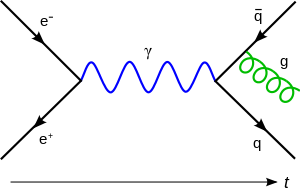Weyl equation
| Quantum field theory |
|---|
| History |
|
Incomplete theories |
|
Scientists
|
In physics, particularly quantum field theory, the Weyl Equation is a relativistic wave equation for describing massless spin-1/2 particles. It is named after the German physicist Hermann Weyl.
Equation
The general equation can be written: [1][2][3]
explicitly in SI units:
where
is a vector whose components are the 2 × 2 identity matrix for μ = 0 and the Pauli matrices for μ = 1,2,3, and ψ is the wavefunction - one of the Weyl spinors.
Weyl spinors
The elements ψL and ψR are respectively the left and right handed Weyl spinors, each with two components. Both have the form
where
is a constant two-component spinor.
Since the particles are massless, i.e. m = 0, the magnitude of momentum p relates directly to the wave-vector k by the De Broglie relations as:
The equation can be written in terms of left and right handed spinors as:
where .
Helicity
The left and right components correspond to the helicity λ of the particles, the projection of angular momentum operator J onto the linear momentum p:
Here .
Derivation
The equations are obtained from the Lagrangian densities
By treating the spinor and its conjugate (denoted by ) as independent variables, the relevant Weyl equation is obtained.
See also
- Dirac equation (which describes massive spin-1/2 particles)
- Angular momentum operator
- Momentum operator
- Spin (physics)
References
- ↑ Quantum Mechanics, E. Abers, Pearson Ed., Addison Wesley, Prentice Hall Inc, 2004, ISBN 978-0-13-146100-0
- ↑ The Cambridge Handbook of Physics Formulas, G. Woan, Cambridge University Press, 2010, ISBN 978-0-521-57507-2.
- ↑ An Introduction to Quantum Field Theory, M.E. Peskin, D.V. Schroeder, Addison-Wesley, 1995, ISBN 0-201-50397-2
Further reading
- Quantum Field Theory, D. McMahon, Mc Graw Hill (USA), 2008, ISBN 978-0-07-154382-8
- Particle Physics (2nd Edition), B.R. Martin, G. Shaw, Manchester Physics, John Wiley & Sons, 2008, ISBN 978-0-470-03294-7
- Supersymmetry P. Labelle, Demystified, McGraw-Hill (USA), 2010, ISBN 978-0-07-163641-4
- The Road to Reality, Roger Penrose, Vintage books, 2007, ISBN 0-679-77631-1
